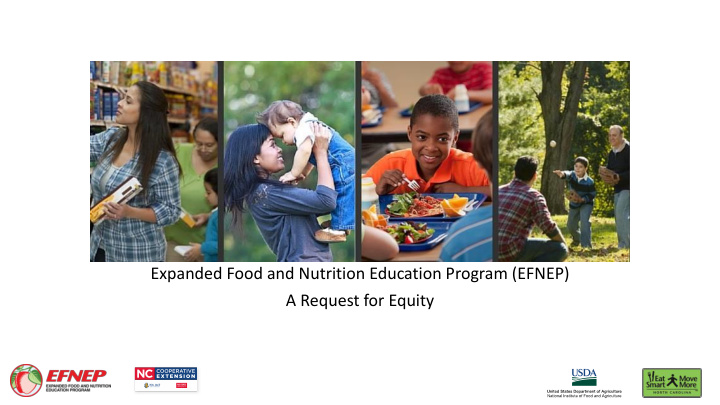



Expanded Food and Nutrition Education Program (EFNEP) A Request for Equity
How the Program Operates Shewana McSwain Lorelei Jones Nutrition Programs Coordinator EFNEP Coordinator NC A&T State University NC State University
Diverse Audience ETHNICITY RACE Other, 4% Hispanic, 27% Black, White, Non- 44% 52% Hispanic, 73%
What is EFNEP? • Federally funded nutrition education program which began in 1969
What is EFNEP? • Federally funded nutrition education program which began in 1969 • Serves low-income families with children and low-income school-aged youth
What is EFNEP? • Federally funded nutrition education program which began in 1969 • Low-income families with children and low-income school-aged youth • Paraprofessionals (Peer Educators) trained and working through Cooperative Extension
EFNEP Priorities Nutrition Food Resource Management Physical Activity Food Safety Food Security
EFNEP Works Research What Makes EFNEP Unique? • For every $1 invested in EFNEP, • Peer Educators there is up to a $10 savings in • Practical, hands-on learning potential health care costs. • EFNEP is the most successful federally funded nutrition education program in increasing fruit and vegetable consumption https://nifa.usda.gov/efnep-research-and-cost-benefit-studies
Positive Behavior Change in Participant • Increased consumption: • Fruit: 55% • Vegetable: 54% • Whole Grains: 47%
Positive Behavior Change in Participant • Increased consumption: • Fruit: 55% • Vegetable: 54% • Whole Grains: 47% • Increased Physical Activity: 50%
Positive Behavior Change in Participant • Increased consumption: • Fruit: 55% • Vegetable: 54% • Whole Grains: 47% • Increased Physical Activity: 50% • Improved Food Resource Management Skills: 90%
Positive Behavior Change in Participant • Increased consumption: • Fruit: 55% • Vegetable: 54% • Whole Grains: 47% • Increased Physical Activity: 50% • Improved Food Resource Management Skills: 90% • Improved Food Safety: 76%
Positive Behavior Change in Participant • Improved dietary intake: 97% • Fruit: 55% • Vegetable: 54% • Whole Grains: 47% • Increased Physical Activity: 50% • Improved Food Resource Management Skills: 90% • Improved Food Safety: 76% • Improved Food Security: 58%
How EFNEP can Address Heart Disease and Stroke Prevention • Utilize evidence-based strategies that result in behavior change
How EFNEP can Address Heart Disease and Stroke Prevention • Utilize evidence-based strategies that result in behavior change • Address risk behaviors • Sodium • Saturated fat • Physical inactivity
EFNEP Success in Reducing Sodium, Solid Fat and Added Sugars Reduced Sodium Intake Reduced SoFAs Intake 59% 60% 57% 57% 54% 53% 56% 56% 2013 2014 2015 2016 2013 2014 2015 2016
Current EFNEP Outreach Alleghany Gates Ashe Northampton Surry Warren Rockingham Caswell Vance Stokes Granville Person Hertford Halifax Watauga Wilkes Yadkin Forsyth Alamance Orange Bertie Durham Franklin Guilford Nash Caldwell Alex- Davie Edgecombe ander Iredell Madison Tyrell Washington Dare Wake Burke Wilson Randolph Chatham McDowell Catawba Pitt Rowan Buncombe Beaufort Johnston Hyde Greene Swain Lee Lincoln Rutherford Cleveland Harnett Cabarrus Wayne Henderson Graham Stanly Lenoir Polk Gaston Craven Tran- sylvania Macon Cherokee Sampson Pamlico Cumberland Clay Jones Hoke Union Anson Duplin Scot- Onslow land Carteret Robeson Bladen Pender EFNEP Counties Columbus New Hanover Brunswick
How EFNEP Funds are Leveraged Total Budget Paraprofessional Salaries and Benefits (70% of Total Budget) Grant, County, 17% 6% Grant, 4% Other, 2% County, 36% Federal, 77% Federal, 58%
Why Equity is needed
How funds requested would be used 20% 10% 70% Paraprofessionals Professionals Education and Teaching Materials
EFNEP Success Story For more about EFNEP and to see the full video visit: https://www.ncfamilieseatingbetter.org/EFNEP/partners-about.php
EFNEP Success Story
Recommend
More recommend